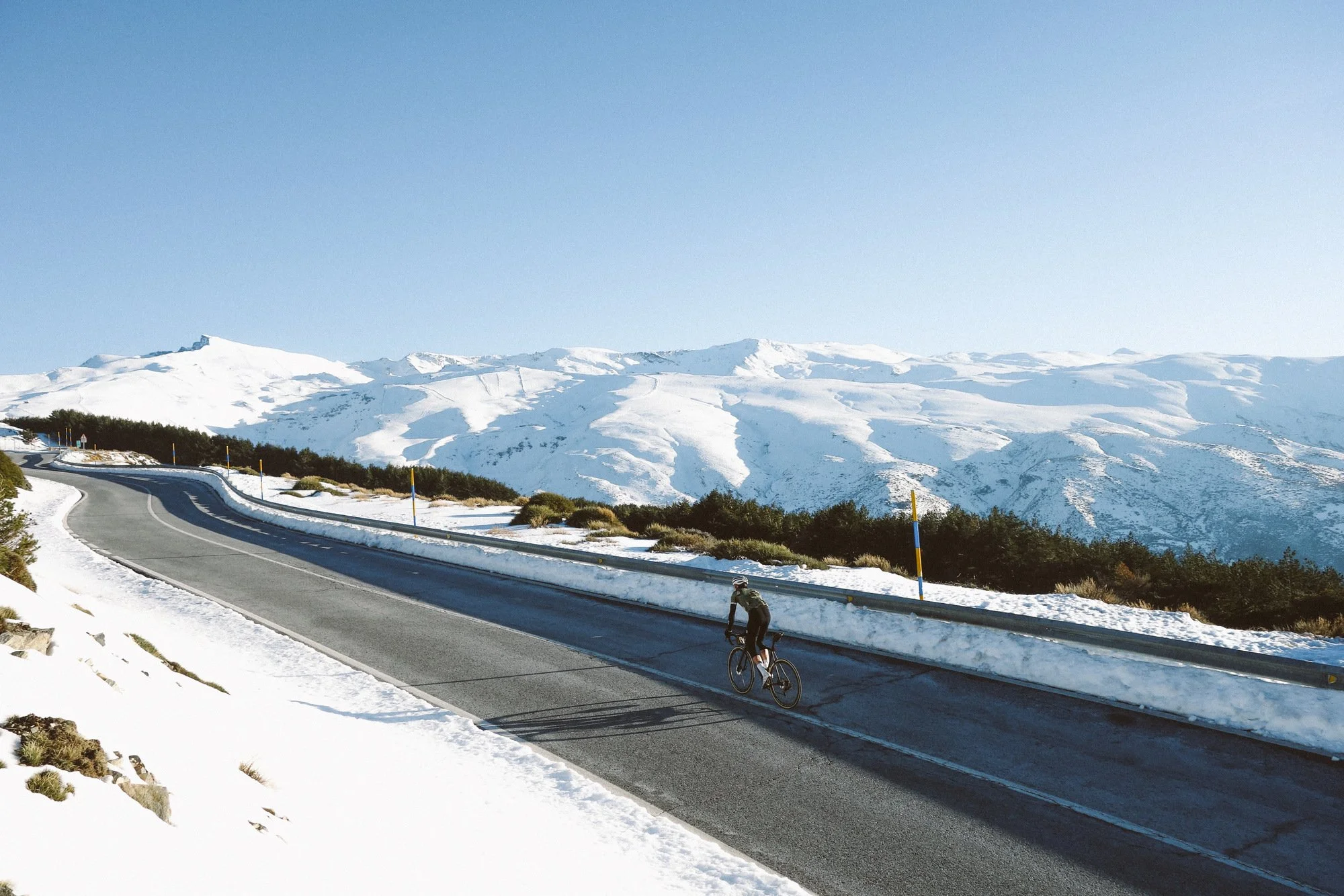Climbing the Pico Veleta: Complete Cycling Guide
Cycling on the A-4025 with the Pico Veleta in the background
key statistics of the CLIMB
Climb Category - HC
Length of climb - 42.2km
Summit elevation - 3,398M
Start elevation - 838M
Elevation gain - 2,700M
Gradient (avg) - 6%
At 3,398 (11,148 ft) metres above sea level the Pico Veleta is Europe's highest paved road and consequently Europe's highest cycling climb. The meaning of the name literally translates as Pico or peak and Veleta meaning "weather vane", the name will perhaps take on a greater resonance as you approach the top.
Overview of the Pico Veleta Climb
The road starts on the edge of Granada at 750 meters and ends at the summit of Pico Veleta, 3398 meters above the world. Forty-three kilometers of climbing. No race crosses it. No Grand Tour dares. The Tour de France has nothing higher. The Vuelta a España turns back at 2500 meters. It is too long, too high, too hard.
Daniel Friebe once wrote that Pico Veleta "is taller and tougher than anything on the Tour de France but lacks in kudos what it offers in elevation precisely because of its height… it is, more simply put, too high. Too high for year-round access and too high, perhaps most to the point, to join the upper crust of professional cycling’s most noble mountains."
And that is the truth. The mountain does not care for glory. It does not seek the approval of grand tours or the adoration of crowds. It stands apart, alone, waiting for those who think they can conquer it. Most do not.
Cyclists with the backdrop of the Pico Veleta, this photo was taken in March.
the Routes of pico veleta
They say there’s more than one way to the top, but each demands something from you. The final 13 kilometers from Hoya de la Mora are closed to traffic. The last 8 kilometers climb at an average of 8%. The final 4 are worse. The road crumbles. The air thins. The mountain decides who reaches the summit.
Before the Barrier (BB)
Thirty kilometers of steady climbing take you to the barrier at Hoya de la Mora. The gradient averages 5.5%. There are places to stop, gas stations, a few hotels, somewhere to refill a bottle or grab a coffee. The pros turn around here. You don’t have to.
aFTER the Barrier (AB)
This is where it gets real. Hoya de la Mora is the last place to refuel. If your bottles are empty, fill them now. The altitude starts to work against you. Thirty kilometers down, thirteen to go.
The last 8 kilometers hold steady at 8%. The final 5 are rough, sharp stones waiting to cut your tires, waiting to turn you around. Check them before you descend. The road will not be kind if you make a mistake.
1. Pinos genil - 41km - 2635m
Pinos Genil is just off the main road from Granada to the Ski Station, it’s a good place to start as there’s places to park or if cycling then it’s a more interesting road then the main road and you go straight into the climb. After the 13.7km there is a Repsol Garage on the left, we tend to stop here to quickly refill the water bottles. From here it’s just another 500m until you turn off the main road at El Dornajo on to the A-4025 and it’s another 13km to the barrier at Hoya de la Mora. From the barrier it’s another 8km to the top, so if you’re running low it’s advisable to top up at one of the kiosks at Hoya del Mora.
2. Monachil - 37.5km - 2723m
Monachil is a village a little further south west of Granada City. From here you start straight into the climb dubbed El Purche, it’s 8.3km and 670m in elevation gain with average gradient of 7.7% and pitches of 13% on the steeper sections. As a point of reference, Sepp Kuss covered this section in 23:51, if you fancy it! From El Purche there’s a brief descent of 1km until you come to the main road, at the 14km marker you pass the Repsol Garage on the left and shortly after turn left at El Dornajo and on to the A-4025 from here it’s just another 13km to Hoya de la Mora or 24km to the Pico.
3. Güéjar Sierra - 43.2km - 2836m
This is probably the toughest route to take on the Pico, once you pass through the village of Güejar Sierra you start on to the climb of Alto de Hazallanas 7.3km with an elevation gain of 704m and and average gradient of 9.5%. You can check out the Strava leaderboard here. From the Hazallanas it’s 12km to barrier or 23km to the top.
4. alternate Güéjar Sierra - 46km - 2777m
A slight variation of the #3 is to continue further into the valley at Güejar Sierra to exclude the Alto de Hazallanas climb. This is one of favourite approaches as it’s very quiet road with beautiful scenery and it’s not as as steep as Hazallanas but you end up at the same place.
These are the steepest sections on the route via Güejar Sierra
Best Time to Ride Pico Veleta
The mountain is open when the mountain allows it. Some years that means May to October. Other years the snow lingers or arrives early, and the road disappears beneath it. Nothing is certain. The photos you see here were taken in early March. That day, the ride ended at the barrier at Hoya de la Mora. The road beyond was lost to the snow. If you want to know, check the webcams at the ski resort in Pradollano. That will tell you more than any calendar ever could.
In summer, the heat is a killer. Granada bakes in July and August, the streets shimmer at 40 degrees or more. Start early, before the sun owns the sky. September and October are better. The heat has eased. The traffic has thinned. The peak, if the mountain allows it, is clear.
Preparation and Tips
Weather Considerations
May and June, September and October—these are the months to aim for. In summer, it is still possible, but start early. The climb is long, and the sun does not forgive.
The weather changes slowly on the way up. Then suddenly. You won’t feel the cold until you stop at the top, and then it hits. Above 2000 meters, there is no shade, no shelter, just open sky and wind. Past 2200 meters, it is even more exposed. On bad days, think hard before pushing beyond the barrier.
Check the webcams at the ski resort of Pradollano to see the current conditions with snow.
Essential Gear
Bring the right gears. A 34t to 34t ratio is best. You might not think you need it, but when the road steepens and the air thins, you will use it.
Tires matter. The road near the top is wrecked, a patchwork of rough asphalt and broken stone. A bike with 30mm to 34mm tires makes the difference between floating over it and fighting it.
What you carry depends on the season. In September, you might climb in a jersey and feel fine. On another day, you might need winter gear just to reach the top. Bring full finger gloves. Bring a jacket. Check your tires before you turn back. If you ride alone, or if you’re the last one up, have a pump and at least two tubes. When the mountain breaks you, it won’t be kind.
Training Tips
Pace yourself. It is a lesson many learn too late. The climb is 42 kilometers. If you hold 14 kilometers an hour, you will climb for three hours. Most don’t make it past the barrier because they burn too soon. They push early, feel strong, and then, when the mountain truly begins, they have nothing left. The mountain does not care. It takes what it wants.
Ride smart. Ride steady. The ones who make it to the top are the ones who understand that strength is not just power, but patience.
where to rent a bike?
Cycle Sierra Nevada offers the BMC Roadmachine to rent, it’s the perfect bike to take on the Pico, climbing ratio gears and 32mm tires. Delivery to Granada can be arranged for as little as 20€. Check the website fort availability and pricing.
OTHER CLIMBS OF THE SIERRA NEVADA
Most cyclists are familiar with the famous Pico Veleta and the high-altitude center at Pradollano, but Granada offers more than just a single climb. Check out the full list of climbs here.
Veni, vidi, vici
I came, I saw, I conquered... well why not get the Pico Veleta jersey to prove it?! (click here)
rIDE THE VELETA WITH US
From September onwards we offer catered packages and the highlight is taking on the Pico Veleta. Why not join us and let us look after all of the logistics, so you can concentrate on just riding your bike? (Learn more)
Ready to Ride granada?
Your dream cycling holiday in the Sierra Nevada and Granada is just a pedal stroke away! At Cycle Sierra Nevada, we offer a comprehensive suite of services designed to make your adventure seamless and unforgettable:
Cycling Holidays & Camps - Join our guided cycling holidays and training camps tailored to all levels—from beginners to seasoned racing cyclists.
Premium Bike Hire - Choose from our meticulously maintained fleet of top-of-the-line bikes, available in a range of sizes to perfectly match your riding style.
Cycling-Friendly Accommodation - Enjoy handpicked lodgings that blend comfort and convenience, ideally located near the region’s best cycling routes and Granada’s cultural landmarks.
Airport Transfers - Begin your adventure stress-free with our reliable airport transfer service, so you can focus on the ride from the moment you land.
We’d love to hear from you! Share your favorite routes, memorable experiences, or even ask questions in the comments—let’s build a community of passionate cyclists. And if you’re curious how our routes stack up against the famed Mallorca cycling routes, just ask!
Contact Information
Cycle Sierra Nevada
Calle Mariana Pineda 13
Vélez de Benaudalla, AL, 18670, Spain
Phone: +34 684205648
Email: info@sierranevada.cc
Let’s make your next cycling adventure one you’ll never forget!









